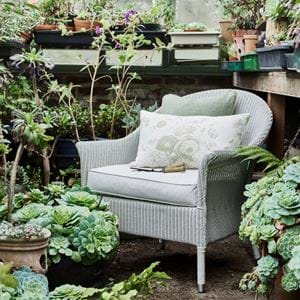I’ll be in the potting shed
I’ll be in the potting shed
Is there a better way to step back from the fast pace of everyday life than heading out to a potting shed?
If you’re lucky, you might have a dedicated shed or outbuilding, complete with a potting bench, a stash of hand-written labels and your tools hung all in a row. A favourite armchair in the corner, maybe, for a bit of floral scheming and dreaming… Or maybe you’ve carved out a corner of your utility room, a conservatory or even your garage. Either way, the steady work of planting seeds, checking on them, and, in time, transferring your new plants to the garden or to larger pots will work its calming magic every time.
If you’re a seasoned gardener, you’ll have your own flower favourites earmarked by now. But if you’re an absolute beginner, fret not. Because potting – combined always with the gentle art of pottering – is a skill that’s easy to get the hang of. After all, it mimics what nature does beautifully all on her own; it’s just giving her a helping hand.
A place for everything
Just as in your home, your potting shed or potting area needs a good measure of order. That way, you have everything you need to hand. You’ll need a stable surface to do your sowing. A good supply of pots and compost. And several shelves that allow you to see what’s starting to germinate and what needs a bit more nurturing. If you need to make your own basic shelves, a couple of scaffolding planks supported on old terracotta pots or bricks will do the job nicely.
What to grow?
A trip to a local National Trust garden – or a smaller one that opens its gates as part of the National Garden Scheme – can provide some great ideas. Whether you fall for dahlias, zinnias, sweet peas or asters, if you’ve spotted them flourishing nearby, there’s a better chance they’ll grow well in your garden too.
Sowing the seeds
Expert gardeners like to plant seeds in rows of three-inch square pots. Admittedly, they aren’t as pretty as round pots, but rows of square ones in a tray mean less gaps for sneaky snails to lurk. Now simply follow the directions on your seed packet until you spot the very first green shoots peeping through.
After that, it’s all about gentle watering, ample sunlight and checking their progress. Too little light or water can produce ‘leggy’ seedlings – too long, spindly and weak to survive.
Planting out
If you’re planting out your new plants in the garden, don’t skip the all important ‘hardening off’ stage. This is when you give your little ones a taste of the great outdoors each day, for about ten days, but then whisk them back indoors for the night.
Pots of choice
If you’re transferring the fruits of your labour into larger pots for the summer, our hardwearing planters are the perfect choice. Fill the base with ‘crocks’ (broken old pots) for drainage, add compost and then get creative. Feel free to mix leafy foliage with flowers, creating a display that works in terms of colour and variety – just as you would a bouquet of flowers.
Fill any gaps with compost so there are no pockets, before watering well to settle in the plants’ roots. Check the soil is nice and moist each day, because, even if it’s rained, leaves can act as a canopy so the rain doesn’t get through to the roots. Ceramic planters look best grouped together – and a bonus is that it makes watering them much easier.
And when your flowers come into bloom, those quiet afternoons of planting, nurturing and watering will seem an age ago. But so worthwhile.












